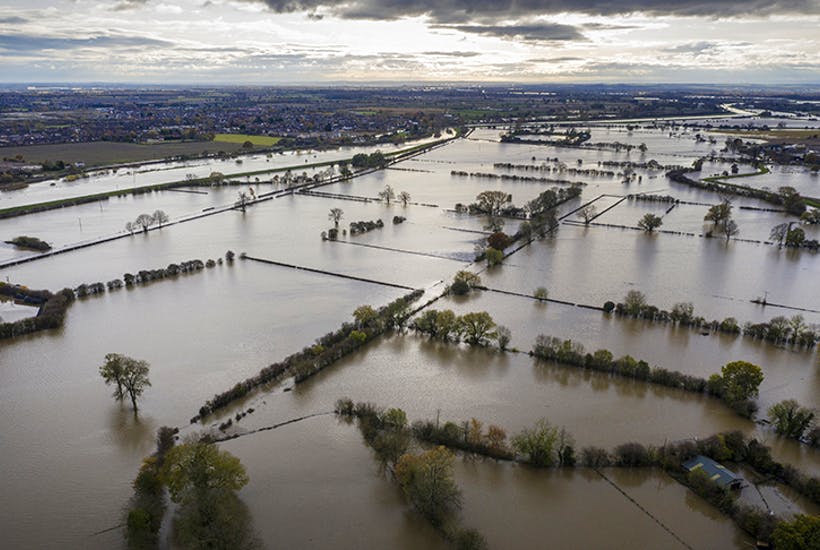
This week’s political fuss over whether the floods in Yorkshire constitute a ‘national emergency’ misses the point. It is too easy to declare an emergency for political purposes, to give the impression that the government is taking an issue seriously. It’s quite obvious that the scenes we have seen this week represent an emergency — the question is whether, once the helicopter visits and photo opportunities have ceased, all is forgotten and the political world moves on to the next emergency.
What has happened in Yorkshire over the past week is a symptom of chronic failure to manage the threat of flooding. We keep suffering these events. In 2015, it was Cumbria; a year earlier it was Somerset. They are not apocalyptic — even in 2012, one of the worst years for flooding, the total number of homes seriously damaged by flooding did not exceed 8,000. Given that there are 23 million homes in England, to be flooded is still a rare and unfortunate occurrence. Nevertheless, floods are, for the most part, avoidable. They happen because we do not have a coherent strategy for managing rivers and maintaining coastal defences. We nibble at the problem, making piecemeal improvements when much more comprehensive action is required.
Every time we have floods, we are told that this is only just the beginning — climate change will make such events much more common. Government ministers and Environment Agency officials both spin this line, not least because it offers a chance to divert attention from their own failures. We hear promises that more money will be spent. Yet the action which follows is laughably out of kilter with the rhetoric on climate change. This year’s central government budget for building new flood defences and maintaining existing ones is £815 million — a pitifully small sum considering it has to cover every river and every mile of coast in England. It is less than a tenth of the £9.8 billion which the government and consumers between them will spend subsidising renewable energy.
Never mind climate change; our flood defences aren’t fit to cope with the climate we already have. In both Yorkshire and Somerset, residents have complained that the Environment Agency had stopped dredging the river, allowing silt to narrow the stream. Floodbanks are too often trusted to the whim of landowners — even though flood defences are only as good as their weakest link. Dams, weirs and storage areas — which used to form part of flood defences — rarely get built any more. We are still relying on flood defence infrastructure which was built prior to the 1980s, much of it in Victorian times.
Flood defence has become subject to a doctrine which puts natural habitats above the interests of all else. In the days of the old National Rivers Authority, defending homes, businesses and farmland with efficient drainage was the priority. Since the Environment Agency took over the management of rivers in 1996, there has been a far greater emphasis on protecting flora and fauna. In some ways this is a good thing. Flood defence and protecting nature are not always at odds — if you can hold water back in absorbent woodland or moorland it slows the passage of rainwater into rivers and streams, protecting wildlife as well as people. But in other cases, where dredging has been abandoned or rushes have been allowed to choke rivers, there is a conflict which too often has come down on the side of habitat protection.
It is a similar story with coastal erosion where stretches of coast have been allowed to fall into the sea — or experience ‘managed retreat’, in the Environment Agency’s lingo. In the end, it took the owners of Bacton Gas Terminal in Norfolk to take matters into their own hands to prevent their nationally-important infrastructure collapsing into the water. They commissioned a Dutch-engineered scheme to dredge sand offshore and used it to rebuild the beaches. It is common practice in the Netherlands, where a quarter of the land lies beneath sea level and would quickly have to be abandoned if that country’s government took the same approach to flood defence as does ours.
Meanwhile, planning policy seems at odds with warnings about greater flood risk in future. It is notable how in so many cases the properties which flood have only recently been built. Since the turn of the century, more than 250,000 new homes have been built in flood risk areas, of which 68,000 were in zones expected to flood more than once in every 100 years and 23,000 were in areas expected to flood at least once in every 30 years. And that is the risk calculated from the existing climate. It’s perfectly sensible to live in such areas if the risk is accepted — and if government can build proper flood defences.
UK governments have taken pride in leading the world in reducing carbon emissions. But it is futile to spend so much money trying to eliminate the 2 per cent of global emissions for which Britain is responsible while doing so little to cope with basic flood risk. Adaptation is going to have to be a large part of the story of climate change, and one that — as we have seen this week — deserves much more attention.